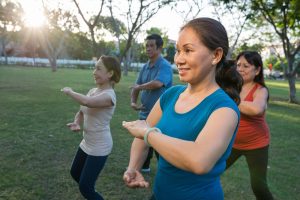Frozen shoulder is a condition that leads to shoulder pain and stiffness. It is also known as adhesive capsulitis or inflammation of the shoulder joint capsule due to thick bands of tissue called adhesions.
It results in gradual loss of movement in the shoulder. Normally the shoulder joint is the most mobile joint in the body. But, when the shoulder is frozen, the joint becomes stuck and its movement is limited. It can affect one or both shoulders. Frozen shoulders can be very distressing and make even daily activities of living difficult; it can become challenging or impossible to get dressed, cook, clean, or shift gears while driving.
Epidemiology
Frozen shoulder is most common in people between the ages of 50 and 60. It is estimated that 2 to 5% of the population are affected by the frozen shoulder at some point, and it is more common in women than in men. People with diabetes are particularly likely to develop a frozen shoulder: About 10 to 20% of them get it, but the exact cause is still unknown.
Risk factors and aetiology
The exact cause is not fully understood. The risk factors for frozen shoulder include:
- Age: >40 years old
- Gender: >70% of sufferers are women.
- Prolonged immobility due to:
- Stroke
- Injury e.g. rotator cuff injury, broken arm
- Recovery from surgery
- Medical conditions:
- Diabetes: 10 to 20% of diabetics develop frozen shoulder, and symptoms are usually more severe. Some research suggests that high blood sugars cause glycosylation of the collagen and therefore stiffness within the shoulder joint.
- Hyperthyroidism (overactive thyroid)
- Hypothyroidism (underactive thyroid)
- Heart disease
- Parkinson’s disease
Clinical features
The main symptoms of frozen shoulder include pain, stiffness and decreased range of movement of the shoulder(s). They develop gradually and usually resolve on their own, in three stages:
- Freezing stage: In this stage, any movement of the shoulder joint will cause pain and your shoulder movement range will be limited. This typically lasts from 6 weeks to 9 months.
- Frozen stage: Pain will begin to subside but stiffness persists in the shoulder and movement will still be restricted. This generally lasts from 4 to 6 months.
- Thawing stage: The pain will subside and the range of motion of the shoulder begins to improve. Complete restoration of normal or near-normal strength and motion usually takes 6 months to 2 years.
Most people only face frozen shoulder once in a lifetime. Recurrence is possible, presenting in the same or opposite shoulder.
Diagnosis
Diagnosis of frozen shoulder is based on symptoms, history, and physical examination.
Physical examination involves assessing limitations to your passive and active range of motion. This range of motion when someone else moves your shoulder is called “passive range of motion.” The doctor will move your shoulder carefully in all directions to see which movements are limited and whether there is pain associated with the motion. Your doctor will compare this to the range of motion you display when you move your shoulder on your own (“active range of motion”). People with frozen shoulder have pain with limited range of both active and passive motion.
There are various differential diagnoses for shoulder pain e.g.
- Bursitis: inflammation of the bursa, a lubricating sac between the rotator cuff and the bone on top of your shoulder (acromion). The bursa allows the rotator cuff tendons to glide freely when you move your arm.
- Rotator cuff tear: The rotator cuff attaches the humerus (upper arm bone) to the scapula (shoulder blade) and helps to lift and rotate your arm.
In both cases, usually pain comes on only with active movement, not with passive movement.
Your doctor may thus also perform imaging tests such as ultrasound/MRI to rule out soft tissue problems of the shoulder (e.g. bursitis, rotator cuff tear) or x-ray to rule out other problems with bony structures like arthritis, arthropathy.
Other investigations may also be done to determine the cause of your symptoms (e.g. diabetes, thyroid disorders).
Treatment
Non-Surgical Treatment
Conservative management is the mainstay of therapy. The goals of non-surgical treatment are to control pain, restore motion and strength.
Medications to control pain
Medical therapy for frozen shoulders includes non-steroidal anti-inflammatory painkillers like ibuprofen. The pain can also be relieved with a steroid injection into the shoulder.
Physiotherapy to restore motion and strength
Physiotherapy with stretching exercises improve the mobility of joints. It is important to note that in performing such exercises, stretch to the point of tension but not pain. Some examples include:
- External rotation — passive stretch. Stand in a doorway and bend your affected arm’s elbow to 90 degrees to reach the doorjamb. Keep your hand in place and rotate your body. Hold for 30 seconds. Relax and repeat.
- Forward flexion — supine position. Lie on your back with your legs straight. Use your unaffected arm to lift your affected arm overhead until you feel a gentle stretch. Hold for 15 seconds and slowly lower to start position. Relax and repeat.
- Crossover arm stretch. Gently pull one arm across your chest just below your chin as far as possible without causing pain. Hold for 30 seconds. Relax and repeat.
If a frozen shoulder is treated with painkillers and physiotherapy, the shoulder range of motion usually restores within a year. Even untreated, the symptoms get better over time but may not result in full functional recovery.
Surgical Treatment
If the above non-surgical methods prove ineffective, surgical treatment may be considered. The goal of surgery is to stretch and release the stiffened joint capsule. The most common methods include:
Manipulation under anaesthesia
The patient is put to sleep under anaesthesia, and the surgeon forces the shoulder to move through a large range of motion. This causes the shoulder capsule and adhesions to stretch or tear in a controlled manner. This releases the stiffening and increases range of motion.
Shoulder Arthroscopy
The doctor will cut through tight portions of the joint capsule using pencil-sized instruments inserted through small incisions around your shoulder.
In many cases, both these methods are employed in combination to obtain maximum results and most patients have good outcomes. Of note, post-operative physiotherapy is vital to maintain improved range of motion and prevent frozen shoulders from recurring.
Alternative Treatment Options
Acupuncture
This purports to reduce shoulder pain and stiffness associated with frozen shoulder by promoting increased blood flow in the shoulder region allowing the capsule to move more naturally.
Prevention
One of the most common causes of frozen shoulder is the immobility that may result during recovery from a shoulder injury, broken arm or a stroke. As prevention is better than cure, should you sustain any of these, talk to your healthcare provider to initiate suitable exercises soonest, to preserve the range of motion in your shoulder joint.












